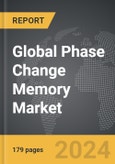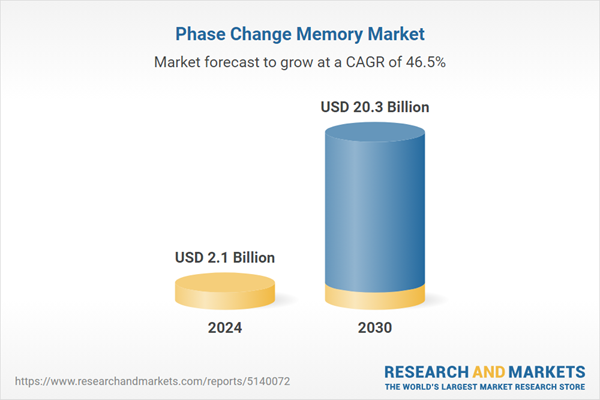Global Phase Change Memory Market - Key Trends & Drivers Summarized
Phase Change Memory (PCM) is an emerging non-volatile memory technology that offers significant advantages over traditional memory types like DRAM and NAND flash. PCM stores data by altering the state of a chalcogenide glass material between its amorphous and crystalline phases, which have distinctly different electrical resistances. This phase change can be triggered by the application of heat through an electrical current. PCM provides several benefits, including faster read and write speeds, higher endurance, and better scalability compared to existing memory technologies. These attributes make PCM a promising candidate for various applications, including data centers, mobile devices, and high-performance computing, where speed, durability, and energy efficiency are critical.Technological advancements have been crucial in advancing PCM technology and making it commercially viable. Innovations in materials science have led to the development of more stable and efficient phase-change materials, improving the performance and reliability of PCM devices. Advances in fabrication techniques have enabled the scaling down of PCM cells, increasing memory density and reducing production costs. Additionally, integration with existing semiconductor manufacturing processes has facilitated the adoption of PCM in mainstream memory applications. Research into multi-level cell (MLC) PCM, which can store multiple bits per cell by utilizing intermediate resistance states, has further enhanced the storage capacity of PCM. These technological developments are driving the adoption of PCM as a next-generation memory solution.
The growth in the phase change memory market is driven by several factors, including the increasing demand for high-speed and high-density memory solutions, advancements in PCM technology, and the rising need for energy-efficient data storage. The growing data-centric applications, such as artificial intelligence, big data analytics, and IoT, require faster and more reliable memory solutions, driving the demand for PCM. Technological advancements in phase-change materials, cell architecture, and fabrication processes have improved the performance and reduced the costs of PCM, making it a competitive alternative to traditional memory technologies. Additionally, the need for energy-efficient and durable memory solutions in mobile devices and data centers has further fueled the adoption of PCM. Government initiatives and investments in research and development of advanced memory technologies are also contributing to market growth. As the demand for high-performance memory continues to rise, the phase change memory market is expected to expand.
Scope of the Study
The report analyzes the Phase Change Memory market, presented in terms of market value (US$ Thousand). The analysis covers the key segments and geographic regions outlined below.Segments:
Technology (PCM as DRAM, PCM as SRAM, PCM as Flash Memory, PCM as SCM); Application (Enterprise Storage, Other Applications).Geographic Regions/Countries:
World; USA; Canada; Japan; China; Europe; France; Germany; Italy; UK; Rest of Europe; Asia-Pacific; Rest of World.Key Insights:
- Market Growth: Understand the significant growth trajectory of the PCM as DRAM Technology segment, which is expected to reach US$10.7 Billion by 2030 with a CAGR of a 48.4%. The PCM as SRAM Technology segment is also set to grow at 46.3% CAGR over the analysis period.
- Regional Analysis: Gain insights into the U.S. market, valued at $555.8 Million in 2024, and China, forecasted to grow at an impressive 53.0% CAGR to reach $6.5 Billion by 2030. Discover growth trends in other key regions, including Japan, Canada, Germany, and the Asia-Pacific.
Report Features:
- Comprehensive Market Data: Independent analysis of annual sales and market forecasts in US$ Million from 2024 to 2030.
- In-Depth Regional Analysis: Detailed insights into key markets, including the U.S., China, Japan, Canada, Europe, Asia-Pacific, Latin America, Middle East, and Africa.
- Company Profiles: Coverage of major players such as IBM Corporation, Samsung Group, Intel Corporation, STMicroelectronics NV, Applied Materials, Inc. and more.
- Complimentary Updates: Receive free report updates for one year to keep you informed of the latest market developments.
Why You Should Buy This Report:
- Detailed Market Analysis: Access a thorough analysis of the Global Phase Change Memory Market, covering all major geographic regions and market segments.
- Competitive Insights: Get an overview of the competitive landscape, including the market presence of major players across different geographies.
- Future Trends and Drivers: Understand the key trends and drivers shaping the future of the Global Phase Change Memory Market.
- Actionable Insights: Benefit from actionable insights that can help you identify new revenue opportunities and make strategic business decisions.
Key Questions Answered:
- How is the Global Phase Change Memory Market expected to evolve by 2030?
- What are the main drivers and restraints affecting the market?
- Which market segments will grow the most over the forecast period?
- How will market shares for different regions and segments change by 2030?
- Who are the leading players in the market, and what are their prospects?
Some of the 11 major companies featured in this Phase Change Memory market report include:
- IBM Corporation
- Samsung Group
- Intel Corporation
- STMicroelectronics NV
- Applied Materials, Inc.
- Taiwan Semiconductor Manufacturing Co., Ltd. (TSMC)
- Western Digital Corporation
- SK Hynix, Inc.
- Om Nanotech Pvt., Ltd.
- Kioxia Holdings Corporation
Table of Contents
Companies Mentioned (Partial List)
A selection of companies mentioned in this report includes, but is not limited to:
- IBM Corporation
- Samsung Group
- Intel Corporation
- STMicroelectronics NV
- Applied Materials, Inc.
- Taiwan Semiconductor Manufacturing Co., Ltd. (TSMC)
- Western Digital Corporation
- SK Hynix, Inc.
- Om Nanotech Pvt., Ltd.
- Kioxia Holdings Corporation
Table Information
| Report Attribute | Details |
|---|---|
| No. of Pages | 179 |
| Published | April 2025 |
| Forecast Period | 2024 - 2030 |
| Estimated Market Value ( USD | $ 2.1 Billion |
| Forecasted Market Value ( USD | $ 20.3 Billion |
| Compound Annual Growth Rate | 46.5% |
| Regions Covered | Global |









